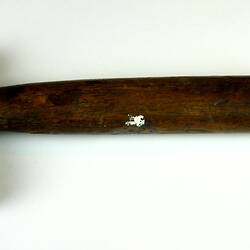Summary
This short-handled, shoe hammer was an essential tool within Stanio Fancoff's shoemaking kit. Used for general purposes, the shoe hammer consolidated damped soles and heels, drove nails and rivets to keep shoes intact and was used in 'peening', whereby the hammer welded the surfaces together to improve the shoe's material qualities. Along with many other tools, the hammer was an essential instrument within the shoemaker's tool kit.
Stanio Ivanoff Fancoff was born in 1908 in Bojentsi, a small village in Bulgaria. At age 11, Stanio left home to learn the shoemaking trade. In 1929, he immigrated to Melbourne, settled in Fitzroy and began to work for the V.G. Zemancheff & Sons basket shoe factory in South Melbourne. In1936, he married Dorotea Georgi Touzou who had recently arrived in Australia. Around this time, Stanio set up his own shoemaking business from home, with Georgi, her cousin and sister weaving the shoes which he then assembled. Select shoe samples were then taken to Sydney and Tasmania for sale. In 1942, Georgi and Stanio moved to Broken Hill for Georgi's health; there daughter Nancy was born and Stanio set up a shoe shop/factory. In 1945, Georgi died and by 1950 Stanio and Nancy had moved to Adelaide where he again opened a shoemaking business and shop. He passed away in 1978, having been in the shoemaking business for 59 years. This collection documents his migration and working life experiences.
Physical Description
This ordinary shoe hammer has on one end a mushroom shaped face, whilst the other end presents a flat cyclindrical pane. The dark coloured metal surface exhibits as an shell of multiple shallow indentations. Looking from atop, the hammer provides visual accounts to its interior construction whereby the wooden handle is tapered to fit within the metal hammer head. The short wooden cyclindrical handle measures approximately 16cm in length and appears in a medium natural wood stain colour. The wooden handle's surface appears randomly dented with a small blotch of cream paint located midway and an area of approximately 1cm squared appears to have broken away from the handle's mainframe.
Significance
This collection is significant in documenting a small migrant business as well as the fashion of a particular period. It is well provenanced and charts the application of trade skills in a new country. It also illustrates the stages of hand shoe manufacture from the 1930s, demonstrating the enduring nature of the tools and patterns that were used.
More Information
-
Collecting Areas
-
Acquisition Information
Donation from Nancy Vasileff, 21 Mar 2007
-
Past Owner or User
-
Classification
-
Category
-
Discipline
-
Type of item
-
Overall Dimensions
90 mm (Width), 27 mm (Depth), 193 mm (Height)
-
References
R.A. Salaman, 'Dictionary of Leather-working Tools c.1700-1950 and Tools of Allied Trades,' London: George Allen and Unwin (Publishers) Ltd, 1986 [Section 2: Boot and Shoe Maker pp18-185]. John Peacock. 'Shoes, The Complete Sourcebook,' London:Thames & Hudson Ltd, 2005. NAA holds file (online) on Vasil George Zemancheff, Fancoff's employer
-
Keywords
Boot & Shoemaking, Bulgarian Communities, Bulgarian Immigration, Immigration, Small Businesses, Tools



